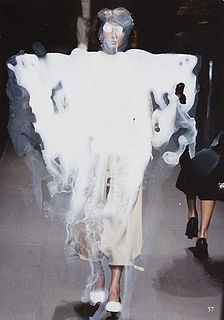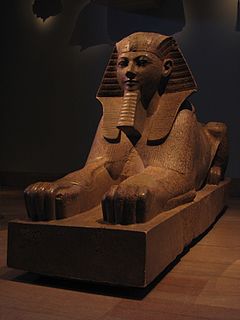
Femininity is a set of attributes, behaviors, and roles generally associated with girls and women. Femininity is partially socially constructed, being made up of both socially defined and biologically created factors. This makes it distinct from the definition of the biological female sex, as both males and females can exhibit feminine traits.
Écriture féminine translates from the French as "women's writing". The theory, which unpacks the relationship between the cultural and psychological inscription of the female body and female difference in language and text, is a strain of feminist literary theory that originated in France in the early 1970s through the work of theorists including Hélène Cixous, Monique Wittig, Luce Irigaray, Chantal Chawaf, Catherine Clément, and Julia Kristeva and has subsequently been extended by writers such as psychoanalytic theorist Bracha Ettinger, who emerged in this field in the early 1990s.
Feminism is a collection of movements aimed at defining, establishing, and defending equal political, economic, and social rights for women. Existentialism is a philosophical and cultural movement which holds that the starting point of philosophical thinking must be the individual and the experiences of the individual, that moral thinking and scientific thinking together are not sufficient for understanding all of human existence, and, therefore, that a further set of categories, governed by the norm of authenticity, is necessary to understand human existence. This philosophy analyzes relationships between the individual and things, or other human beings, and how they limit or condition choice.
Femizon may refer to one of two fictional groups appearing in American comic books published by Marvel Comics.
Concentrative movement therapy (CMT) is a psychotherapeutic method for group and individual therapy which is based on thought models stemming from psychodynamic psychotherapy and depth psychology. Taking as its point of departure the theory that perception is composed of sensation and experience, CMT is interested in the conscious perception of the body in the "here and now" against the background of the individual life and learning story.

Culture and menstruation is about cultural aspects surrounding how society views menstruation. A "menstrual taboo" is any social taboo concerned with menstruation. In some societies it involves menstruation being perceived as unclean or embarrassing, inhibiting even the mention of menstruation whether in public or in private. Many traditional religions consider menstruation ritually unclean, although anthropologists point out that the concepts 'sacred' and 'unclean' may be intimately connected.

Feminist art is a category of art associated with the late 1960s and 1970s feminist movement. Feminist art highlights the societal and political differences women and those of other gender identity experience within their lives. The hopeful gain from this form of art is to bring a positive and understanding change to the world, in hope to lead to equality. Media used range from traditional art forms such as painting to more unorthodox methods such as performance art, conceptual art, body art, craftivism, video, film, and fiber art. Feminist art has served as an innovative driving force towards expanding the definition of art through the incorporation of new media and a new perspective.

Feminists have long struggled with Sigmund Freud's classical model of gender and identity development and reality, which centers around the Oedipus complex. Freud's model, which became integral to orthodox psychoanalysis, suggests that because women lack the visible genitals of the male, they feel they are "missing" the most central characteristic necessary for gaining narcissistic value—therefore developing feelings of gender inequality and penis envy. In his late theory on the feminine, Freud recognized the early and long lasting libidinal attachment of the daughter to the mother during the pre-oedipal stages. Feminist psychoanalysts have confronted these ideas and reached different conclusions. Some generally agree with Freud's major outlines, modifying it through observations of the pre-Oedipal phase. Others reformulate Freud's theories more completely.

Odalisque With Raised Arms is a painting by Henri Matisse, completed in 1923. The oil on canvas measuring 23 by 26 inches is in the National Gallery of Art, Washington D.C. Matisse's style changed and evolved drastically throughout his career, including a wide and varying collection of paintings depicting the female nude. His Odalisque paintings were inspired by his trip to Morocco. Many of the female subjects in the Odalisque paintings were modeled after Matisse's main model at the time, Henriette Darricarrère.
French post-structuralist feminism takes post-structuralism and combines it with feminist views and looks to see if a literary work has successfully used the process of mimesis on the image of the female. If successful, then a new image of a woman has been created by a woman for a woman, therefore it is not a biased opinion created by men. Along with Luce Irigaray and Julia Kristeva, Hélène Cixous is considered one of the mothers of poststructuralist feminist theory. Since the 1990s, these three together with Bracha Ettinger have considerably influenced French feminism and feminist psychoanalysis.

Penis envy is a stage theorized by Sigmund Freud regarding female psychosexual development, in which young girls experience anxiety upon realization that they do not have a penis. Freud considered this realization a defining moment in a series of transitions toward a mature female sexuality and gender identity. In Freudian theory, the penis envy stage begins the transition from an attachment to the mother to competition with the mother for the attention, recognition and affection of the father. The parallel reaction of a boy's realization that women do not have a penis is castration anxiety.
Womyn-born womyn (WBW) is a term developed during second-wave feminism to designate women who were identified as female at birth, were raised as girls, and identify as women.
In architecture and spatial design, atmosphere refers to the sensorial qualities that a space emits. Atmosphere is an immediate form of physical perception, and is recognised through emotional sensibility. Architects and designers use the notion of atmosphere to argue that architecture and space is designed and built for people to use and experience. Peter Zumthor in his book Atmospheres constitutes architectural atmospheres as "this singular density and mood, this feeling of presence, well-being, harmony, beauty...under whose spell I experience what I otherwise would not experience in precisely this way".

In lucha libre, an exótico is a luchador fighting/performing in drag. The exótico’s movement vocabulary is campy, often silly, and seldom dignified. Exóticos are male wrestlers who appropriate feminine aspects in their wrestling personas or "gimmicks" – through feminine costumes, for example, ‘contesting the dramatic representation of machismo’ and successfully unmanning their opponents in the ring while also ‘rejecting the outward signs of manhood’. Though Exoticos may not necessarily be gay, they often are, and their sexual ambiguity is undeniable. Attired with feather boas, headdresses, sequins or stockings, they defy a religious Latin culture that is ardently macho.
The feminine beauty ideal is "the socially constructed notion that physical attractiveness is one of women's most important assets, and something all women should strive to achieve and maintain". Feminine beauty ideals are rooted in heteronormative beliefs, and heavily influence women of all sexual orientations. The feminine beauty ideal, which also includes female body shape, varies from culture to culture. Pressure to conform to a certain definition of "beautiful" can have psychological effects, such as depression, eating disorders, and low self-esteem, starting from an adolescent age and continuing into adulthood.
In feminist theory, the male gaze is the act of depicting women and the world, in the visual arts and in literature, from a masculine, heterosexual perspective that presents and represents women as sexual objects for the pleasure of the male viewer. In film and photograhy, the male gaze has three perspectives: (i) that of the man behind the camera, (ii) that of the male characters within the film's cinematic representations; and (iii) that of the spectator gazing at the image.

An honorary male or honorary man is a woman who is accorded the status of a man without disrupting the patriarchal status quo. Such a woman might be considered "one of the guys" by the men she associates with.











